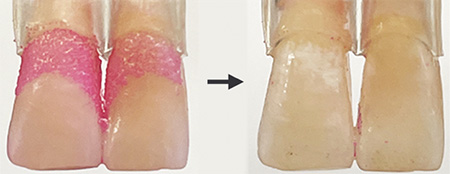Researchers Call in a Swarm of Tiny, Tooth-Scrubbing Robots
Research Quick Pics
The concept of a toothbrush—essentially bristles-on-a-stick—hasn’t changed much as a technology since the Babylonians and ancient Egyptians walked the earth over 5,000 years ago. Now, scientists at the University of Pennsylvania aim to transform tooth cleaning with a swarm of microscopic “robots” that can do the job of a toothbrush, dental floss, and oral rinse all in one, as the video above shows. The NIDCR-supported study, published in the journal ACS Nano, demonstrates the feasibility of the robotic system, which could one day be adapted for use in humans.
“We want to improve oral health for people with disabilities and geriatric populations who don’t have the manual dexterity to perform routine oral care,” says dentist-scientist and senior author Hyun (Michel) Koo, DDS, PhD. “It’s an unmet need in oral health care, and it’s time to disrupt the technology.”
The robots are actually nano-sized iron-oxide particles, each roughly 100 times smaller than a grain of pollen. In the presence of a magnet, the nanoparticles cluster into a series of strands—aka bristles—that align along the direction of the magnetic field. By making finely tuned adjustments to the field, the researchers could precisely direct the bristles’ movements, adjust their stiffness, and shorten or lengthen them.
“One of the great things about working with magnetic fields is that they penetrate tissues and are harmless at the level we use them, meaning the system can reach difficult-to-access spaces,” says microrobotics engineer and co-senior author Edward Steager, PhD.
The researchers tested the robots’ scrubbing powers on several surfaces, including a 3D-printed model of human front teeth, real human front teeth mounted on artificial gums, and a section of a pig jaw containing gums and teeth.
As the video above shows, these robotic structures can be automated to shapeshift from bristle-like extensions to floss-like strings that conform to tooth surfaces and scrub the nooks and crannies between teeth. A separate experiment showed that they are soft enough to leave pig gums undamaged, but strong enough to break up biofilms, also known as plaque, the sticky networks of bacteria that cling to oral surfaces and contribute to tooth decay and gum disease.
When it comes to busting biofilms, these robotic nanoparticles have another trick up their sleeves. They have a natural ability to trigger chemical reactions that release microbe-killing molecules, essentially creating an antimicrobial rinse on-site. In the experiments, this allowed the tiny robotic armies to both break apart biofilms and kill the bacteria within, leaving behind no detectible live pathogens. The robots could also sweep up and collect dead-pathogen-containing debris. According to the scientists, the microbial contents of this material can be analyzed to detect pathogens and other disease indicators, which one day could prove useful for predicting and diagnosing disease in the oral cavity and elsewhere in the body.
But before dispatching a platoon of tiny robots into our mouths, the researchers say clinical trials are needed. To optimize the robotic system and make it affordable for everyday use, the team plans to design prototypes that fit inside the mouth. They envision a programmable, fully automated system that can adapt to the unique features of a person’s oral cavity, enabling personalized oral care.
The group is exploring other applications as well. In a proof-of-concept study recently published in the Journal of Dental Research, the researchers showed that microrobots can be magnetically guided through the root canal—the narrow channel that runs through the interior of a tooth root—to remove biofilms and potentially carry and deliver drugs.
Beyond dentistry, the scientists see a role for the technology in cleaning inside biofilm-contaminated catheters, surgical implants, and even water pipes. “When you see this kind of result that opens a whole new area and applications, it’s as exciting as it gets in research,” says Steager.
References
Surface Topography-Adaptive Robotic Superstructures for Biofilm Removal and Pathogen Detection on Human Teeth. Oh MJ, Babeer A, Liu Y, Ren Z, Wu J, Issadore DA, Stebe KJ, Lee D, Steager E, Koo H. ACS Nano. 2022 Jun 28. doi: 10.1021/acsnano.2c01950. Epub ahead of print. PMID: 35764312.
Microrobotics for Precision Biofilm Diagnostics and Treatment. Babeer A, Oh MJ, Ren Z, Liu Y, Marques F, Poly A, Karabucak B, Steager E, Koo H. J Dent Res. 2022 Aug;101(9):1009-1014. doi: 10.1177/00220345221087149. Epub 2022 Apr 21. PMID: 35450484.
Attention Editors
Reprint this article in your own publication or post to your website. NIDCR News articles are not copyrighted. Please acknowledge NIH's National Institute of Dental and Craniofacial Research as the source.
Subscribe for NIDCR Updates
Receive email updates about the latest advances in dental, oral, and craniofacial research.
October 2024


